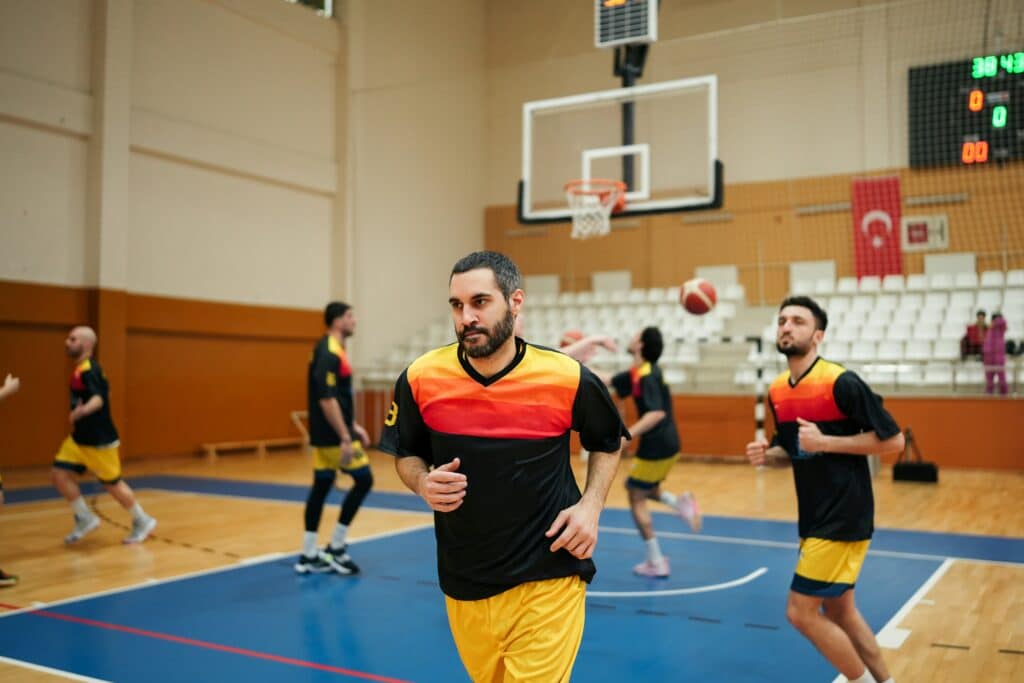
How to Design Effective Basketball Practice Plans with Drills: Getting the Most From Your Practices
Creating an effective practice plan is essential for maximizing player development, improving team performance, and ensuring that each session is engaging and productive.
A well-structured practice plan that includes a range of carefully chosen drills can help basketball coaches achieve these goals by focusing on skill-building, teamwork, and strategic gameplay.
Whether you’re coaching youth basketball players or professionals, a solid practice framework helps players develop their strengths while addressing areas that need improvement.
Here’s a comprehensive guide to designing effective practice plans with basketball drills, covering the key elements and strategies that will lead to success on the court.

1. Define Your Practice Goals
Importance of Setting Clear Goals:
Setting clear goals is critical to ensuring that each practice session is purposeful and efficient. Establishing specific objectives—whether related to individual skills, team performance, or tactical development—guides the selection of drills and helps players focus on what needs to be achieved.
Instructions for Implementing This:
- Identify Main Objectives: Before the session, decide on primary objectives such as improving shooting accuracy, defensive rotations, or teamwork.
- Break Down the Goals: Divide these larger objectives into smaller, manageable goals that can be addressed in specific drills. For example, if improving defense is the goal, one drill could focus on defensive positioning, while another targets closing out shooters.
- Align Drills with Objectives: Choose basketball team drills that directly support your goals, and make sure each drill is focused on either individual skills (e.g., ball handling) or team strategies (e.g., transition defense).
- Communicate Goals to Players: Let players know what the goals for the practice are so they can stay focused and understand the purpose behind each drill.
Tips:
- Tip #1: Regularly review team progress to adjust practice goals as needed. If you’ve made significant progress in one area, shift focus to other skills or strategies.
- Tip #2: Include both individual and team-oriented goals in each practice to create a balanced approach to development.

2. Structure Your Practice Time
Importance of Time Management:
A well-organized practice ensures that players stay engaged and that all critical skills and strategies are covered. Structuring time effectively allows for smooth transitions between drills and ensures players get the maximum benefit from each segment.
Instructions for Implementing This:
- Divide the Session: Split the practice into key segments such as warm-ups, individual skill drills, team drills, and scrimmages. This ensures each area gets attention.
- Set Time Limits: Assign specific time slots to each drill or segment. For example, dedicate 15 minutes to basketball shooting drills, followed by 10 minutes of basketball defensive drills, and 20 minutes for scrimmage or tactical work.
- Balance Skill Development and Scrimmages: Ensure that players get a mix of drills that focus on skill development and game-like situations (e.g., scrimmages or 5-on-5 play).
- Stick to the Plan: Use a timer or practice clock to ensure transitions between drills are smooth and time limits are respected.
Tips:
- Tip #1: Leave room for flexibility—if a drill is particularly effective or if players need extra work in a specific area, don’t hesitate to extend the time on that drill.
- Tip #2: Make adjustments based on player energy levels and engagement. If players seem fatigued, mix in lighter drills or incorporate more breaks.
3. Incorporate a Variety of Drills
Importance of Variety in Drills:
Using a variety of drills helps keep players engaged and ensures that all aspects of their game are developed. Repeating the same drills can lead to boredom and diminishing returns, while mixing things up challenges players to apply skills in different contexts.
Instructions for Implementing This:
- Cover All Skill Areas: Select drills that address various skills such as dribbling, shooting, basketball passing drills, defense, and teamwork. Make sure to include drills that focus on individual development (e.g., free-throw shooting) and team development (e.g., defensive rotations).
- Simulate Game Situations: Incorporate drills that mimic real-game scenarios. For example, set up fast-break drills or create late-game situational play to teach decision-making under pressure.
- Rotate Drills Regularly: Introduce new drills or variations to prevent practice sessions from becoming repetitive. This keeps players mentally engaged and pushes them to adapt to new challenges.
- Balance Individual and Team Drills: While individual skill development is crucial, don’t neglect team-oriented drills that develop chemistry and communication, such as half-court defensive rotations or offensive set basketball plays.
Tips:
- Tip #1: Make sure drills are appropriate for the players’ age and skill level. Young players may need simpler drills with more instruction, while advanced players can handle more complex, high-pressure drills.
- Tip #2: Encourage player feedback on drills—if they find a certain drill particularly helpful or engaging, consider incorporating it more often.

4. Emphasize Skill Progressions
Importance of Progressions in Skill Development:
Skill progressions help players build a solid foundation before advancing to more complex techniques. Gradually increasing the difficulty of drills challenges players to apply their skills in more demanding situations.
Instructions for Implementing This:
- Start with Fundamentals: Begin practice sessions with basic drills that reinforce basketball fundamentals like footwork, passing, or shooting form.
- Increase Difficulty Over Time: Once players demonstrate proficiency in basic drills, increase the complexity by adding defenders, time constraints, or combining multiple skills. For example, move from simple layups to layups under defensive pressure.
- Combine Drills for Advanced Progressions: Combine different drills to simulate more complex game situations. For instance, run a drill that requires players to dribble, pass, and shoot in one continuous motion.
- Monitor Performance: Keep an eye on player performance during progressions and adjust drills accordingly if players are struggling or excelling.
Tips:
- Tip #1: Provide clear instructions and demonstrations before introducing new drills to ensure players understand the goals and mechanics.
- Tip #2: Offer constructive feedback and highlight areas for improvement while reinforcing positive progress.
5. Include Competitive Elements
Importance of Competition in Practice:
Adding competitive elements to practice drills simulates game-like pressure, encouraging players to stay focused, motivated, and aggressive. Basketball competition drills help players develop mental toughness and make faster decisions under pressure.
Instructions for Implementing This:
- Create Challenges: Set up team or individual challenges such as free-throw shooting contests or timed dribbling drills where players compete for accuracy and speed.
- Simulate Game Pressure: Use drills that simulate end-of-game situations or fast breaks to put pressure on players to perform under time constraints.
- Reward Effort: Provide recognition or small rewards for players who excel in competitive drills. This can be as simple as positive feedback or extra playing time in scrimmages.
- Maintain Positive Competition: Ensure that competition remains constructive and supportive, focusing on skill development rather than just winning.
Tips:
- Tip #1: Keep competitive drills short and fast-paced to maintain intensity and keep players engaged.
- Tip #2: Use a mix of individual and team competitions to promote both personal growth and teamwork.

6. Plan for Individual Player Development
Importance of Individualized Development:
Every player has unique strengths and weaknesses. Designing drills that target specific development areas ensures that all players improve, regardless of their starting skill level.
Instructions for Implementing This:
- Assess Strengths and Weaknesses: Regularly evaluate players to identify areas where they need improvement, such as shooting mechanics or defensive positioning.
- Tailor Drills to Individual Needs: Choose drills that address specific skills for each player. For example, if a player struggles with shooting consistency, incorporate shooting drills with varying distances and angles.
- Provide Personalized Feedback: During practice, give individual players specific feedback and support that addresses their unique needs.
- Track Progress: Keep records of individual player performance to assess improvement and adjust practice plans accordingly.
Tips:
- Tip #1: Don’t overlook player feedback—understand what areas they feel they need to work on, and incorporate drills that help them develop those skills.
- Tip #2: Use player development drills not only to improve weaknesses but also to further enhance their strengths.

7. Evaluate and Adjust
Importance of Evaluation and Flexibility:
A practice plan is only as good as its results. Regular evaluation of both the drills and overall practice effectiveness ensures that players are developing and goals are being met.
Instructions for Implementing This:
- Observe Performance: During practice, pay attention to how well players are executing drills and whether they’re making noticeable progress in key areas.
- Collect Feedback: Ask players for feedback on what they found challenging or helpful. Gather insights from assistants to get a complete picture of practice effectiveness.
- Adjust as Needed: If a drill isn’t producing the desired results, be willing to modify or replace it. Similarly, if players have mastered a skill, increase the challenge or introduce new drills.
- Continuously Refine: Make adjustments to your practice structure and drills over time to ensure ongoing player development.
Tips:
- Tip #1: Conduct regular team and individual evaluations to ensure drills align with your long-term goals.
- Tip #2: Stay flexible and be open to changing drills if you see an opportunity for better player development.
How to Design Effective Practice Plans with Drills Conclusion:
Designing an effective practice plan is a dynamic process that requires clear objectives, thoughtful organization, and a diverse set of drills.
By focusing on goal-setting, time management, skill progressions, competitive elements, and individual player development, a basketball coach can create practice sessions that foster both individual and team growth.
Regular evaluation and the willingness to adjust plans ensure that basketball players continue to develop and improve.



